University Report: Safeguarding Adults and Promoting Independence
VerifiedAdded on 2020/06/06
|7
|1869
|76
Report
AI Summary
This report provides a comprehensive overview of safeguarding adults and promoting independence. It begins by defining various forms of abuse, including physical, sexual, psychological, discriminatory, and domestic abuse, along with their respective indicators. The report then explores factors that contribute to abusive situations, such as environmental contexts and vulnerable populations. Key legislation and regulations governing safeguarding adult work are examined, including the Safeguarding Vulnerable Groups Acts, the Rehabilitation of Offenders Act, and the Human Rights Act. Furthermore, the report details working strategies and procedures used in health and social care to reduce the risk of abuse, such as the Disclosure and Barring Service and No Secrets guidance. Finally, the importance of supportive relationships in minimizing the risk of abuse and neglect is emphasized, highlighting principles like fostering equity, promoting rights, and maintaining confidentiality. The report concludes by summarizing the key findings and emphasizing the importance of safeguarding adults in society.
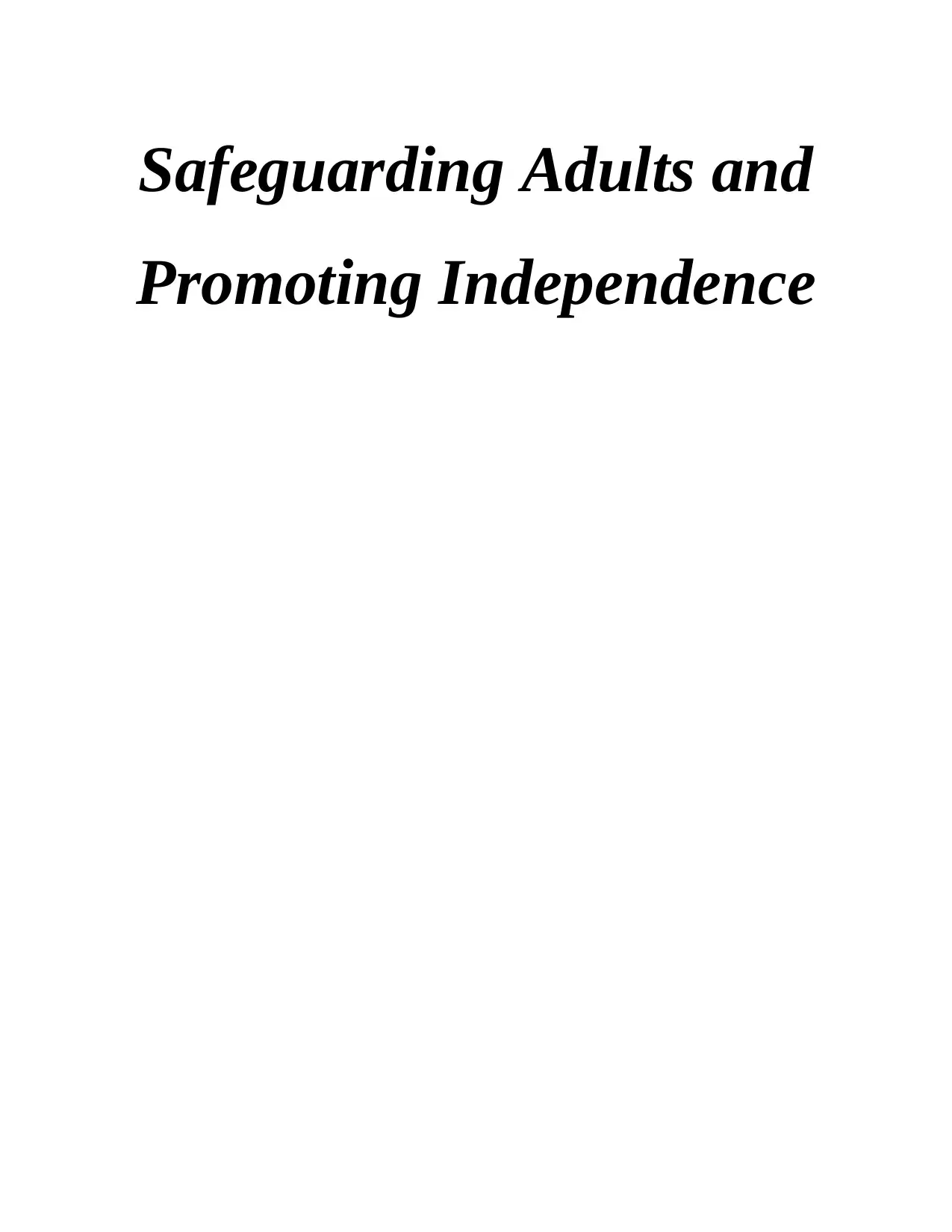
Safeguarding Adults and
Promoting Independence
Promoting Independence
Paraphrase This Document
Need a fresh take? Get an instant paraphrase of this document with our AI Paraphraser
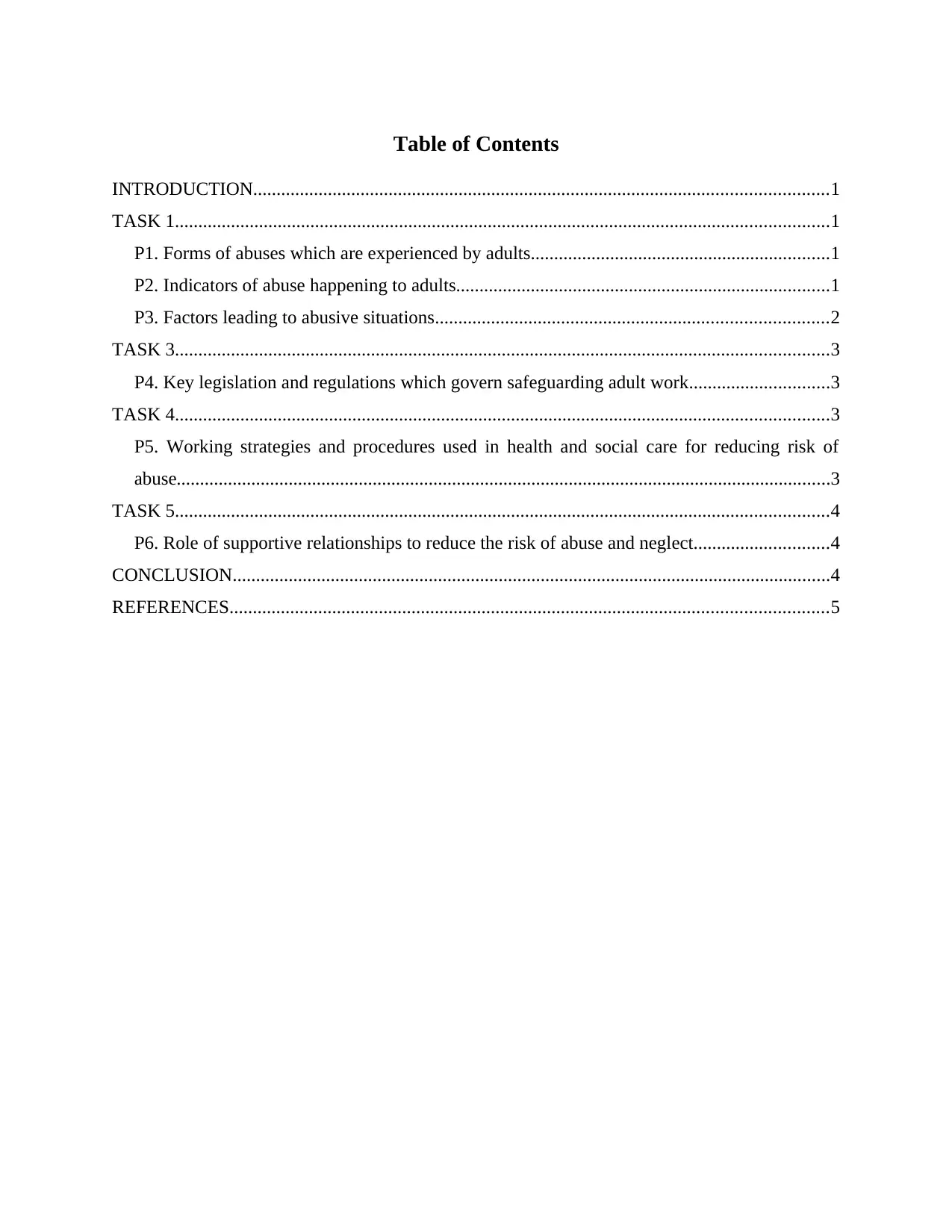
Table of Contents
INTRODUCTION...........................................................................................................................1
TASK 1............................................................................................................................................1
P1. Forms of abuses which are experienced by adults................................................................1
P2. Indicators of abuse happening to adults................................................................................1
P3. Factors leading to abusive situations....................................................................................2
TASK 3............................................................................................................................................3
P4. Key legislation and regulations which govern safeguarding adult work..............................3
TASK 4............................................................................................................................................3
P5. Working strategies and procedures used in health and social care for reducing risk of
abuse............................................................................................................................................3
TASK 5............................................................................................................................................4
P6. Role of supportive relationships to reduce the risk of abuse and neglect.............................4
CONCLUSION................................................................................................................................4
REFERENCES................................................................................................................................5
INTRODUCTION...........................................................................................................................1
TASK 1............................................................................................................................................1
P1. Forms of abuses which are experienced by adults................................................................1
P2. Indicators of abuse happening to adults................................................................................1
P3. Factors leading to abusive situations....................................................................................2
TASK 3............................................................................................................................................3
P4. Key legislation and regulations which govern safeguarding adult work..............................3
TASK 4............................................................................................................................................3
P5. Working strategies and procedures used in health and social care for reducing risk of
abuse............................................................................................................................................3
TASK 5............................................................................................................................................4
P6. Role of supportive relationships to reduce the risk of abuse and neglect.............................4
CONCLUSION................................................................................................................................4
REFERENCES................................................................................................................................5
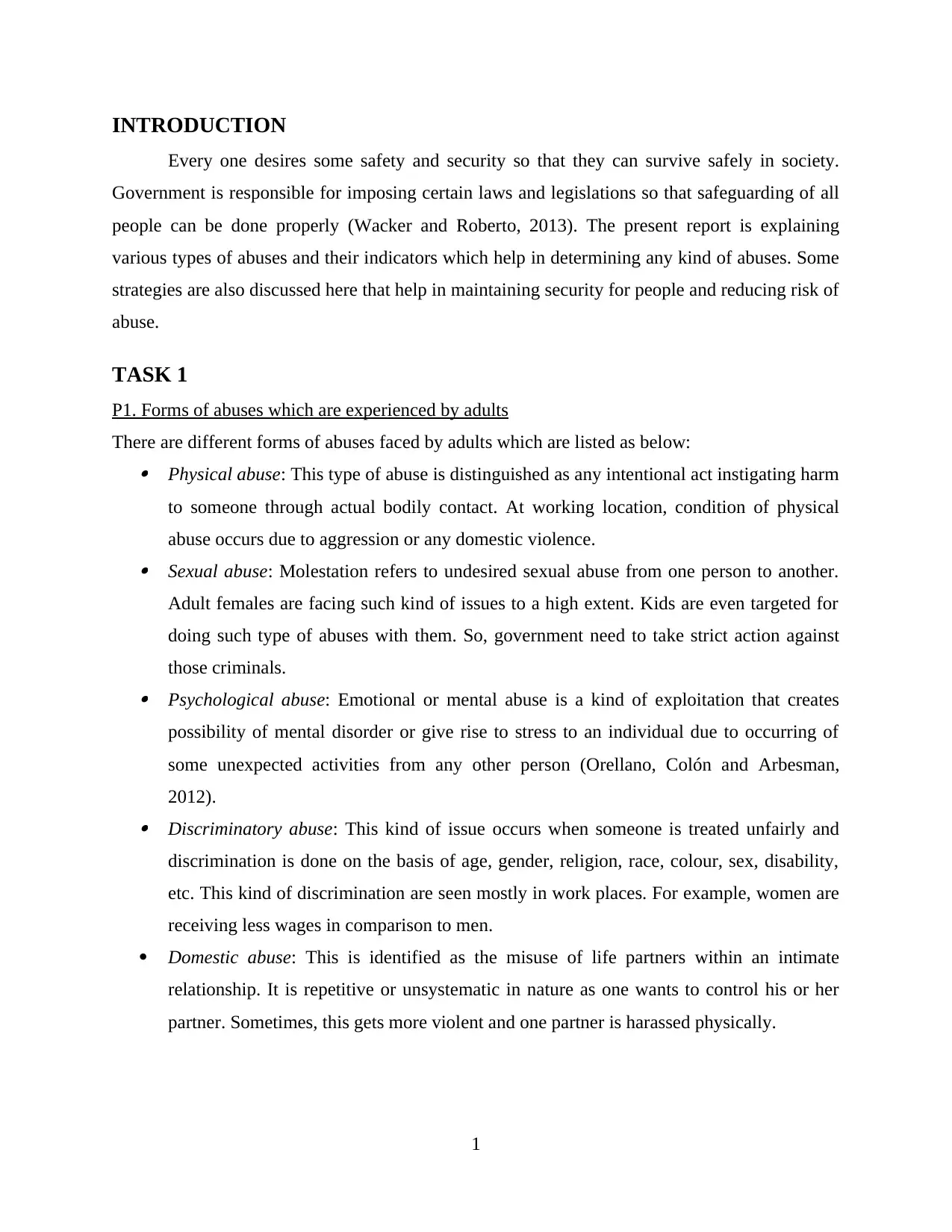
INTRODUCTION
Every one desires some safety and security so that they can survive safely in society.
Government is responsible for imposing certain laws and legislations so that safeguarding of all
people can be done properly (Wacker and Roberto, 2013). The present report is explaining
various types of abuses and their indicators which help in determining any kind of abuses. Some
strategies are also discussed here that help in maintaining security for people and reducing risk of
abuse.
TASK 1
P1. Forms of abuses which are experienced by adults
There are different forms of abuses faced by adults which are listed as below: Physical abuse: This type of abuse is distinguished as any intentional act instigating harm
to someone through actual bodily contact. At working location, condition of physical
abuse occurs due to aggression or any domestic violence. Sexual abuse: Molestation refers to undesired sexual abuse from one person to another.
Adult females are facing such kind of issues to a high extent. Kids are even targeted for
doing such type of abuses with them. So, government need to take strict action against
those criminals. Psychological abuse: Emotional or mental abuse is a kind of exploitation that creates
possibility of mental disorder or give rise to stress to an individual due to occurring of
some unexpected activities from any other person (Orellano, Colón and Arbesman,
2012). Discriminatory abuse: This kind of issue occurs when someone is treated unfairly and
discrimination is done on the basis of age, gender, religion, race, colour, sex, disability,
etc. This kind of discrimination are seen mostly in work places. For example, women are
receiving less wages in comparison to men.
Domestic abuse: This is identified as the misuse of life partners within an intimate
relationship. It is repetitive or unsystematic in nature as one wants to control his or her
partner. Sometimes, this gets more violent and one partner is harassed physically.
1
Every one desires some safety and security so that they can survive safely in society.
Government is responsible for imposing certain laws and legislations so that safeguarding of all
people can be done properly (Wacker and Roberto, 2013). The present report is explaining
various types of abuses and their indicators which help in determining any kind of abuses. Some
strategies are also discussed here that help in maintaining security for people and reducing risk of
abuse.
TASK 1
P1. Forms of abuses which are experienced by adults
There are different forms of abuses faced by adults which are listed as below: Physical abuse: This type of abuse is distinguished as any intentional act instigating harm
to someone through actual bodily contact. At working location, condition of physical
abuse occurs due to aggression or any domestic violence. Sexual abuse: Molestation refers to undesired sexual abuse from one person to another.
Adult females are facing such kind of issues to a high extent. Kids are even targeted for
doing such type of abuses with them. So, government need to take strict action against
those criminals. Psychological abuse: Emotional or mental abuse is a kind of exploitation that creates
possibility of mental disorder or give rise to stress to an individual due to occurring of
some unexpected activities from any other person (Orellano, Colón and Arbesman,
2012). Discriminatory abuse: This kind of issue occurs when someone is treated unfairly and
discrimination is done on the basis of age, gender, religion, race, colour, sex, disability,
etc. This kind of discrimination are seen mostly in work places. For example, women are
receiving less wages in comparison to men.
Domestic abuse: This is identified as the misuse of life partners within an intimate
relationship. It is repetitive or unsystematic in nature as one wants to control his or her
partner. Sometimes, this gets more violent and one partner is harassed physically.
1
⊘ This is a preview!⊘
Do you want full access?
Subscribe today to unlock all pages.

Trusted by 1+ million students worldwide
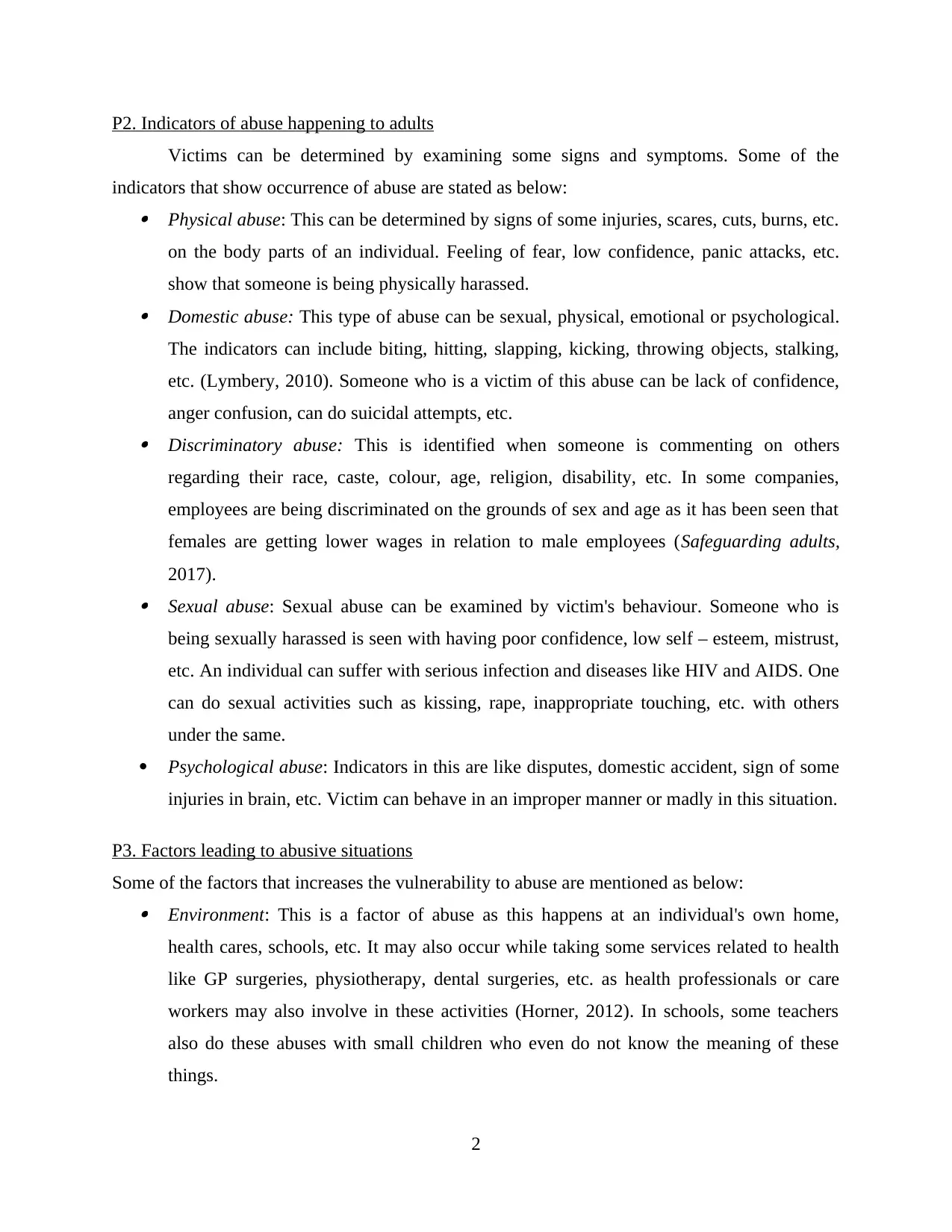
P2. Indicators of abuse happening to adults
Victims can be determined by examining some signs and symptoms. Some of the
indicators that show occurrence of abuse are stated as below: Physical abuse: This can be determined by signs of some injuries, scares, cuts, burns, etc.
on the body parts of an individual. Feeling of fear, low confidence, panic attacks, etc.
show that someone is being physically harassed. Domestic abuse: This type of abuse can be sexual, physical, emotional or psychological.
The indicators can include biting, hitting, slapping, kicking, throwing objects, stalking,
etc. (Lymbery, 2010). Someone who is a victim of this abuse can be lack of confidence,
anger confusion, can do suicidal attempts, etc. Discriminatory abuse: This is identified when someone is commenting on others
regarding their race, caste, colour, age, religion, disability, etc. In some companies,
employees are being discriminated on the grounds of sex and age as it has been seen that
females are getting lower wages in relation to male employees (Safeguarding adults,
2017). Sexual abuse: Sexual abuse can be examined by victim's behaviour. Someone who is
being sexually harassed is seen with having poor confidence, low self – esteem, mistrust,
etc. An individual can suffer with serious infection and diseases like HIV and AIDS. One
can do sexual activities such as kissing, rape, inappropriate touching, etc. with others
under the same.
Psychological abuse: Indicators in this are like disputes, domestic accident, sign of some
injuries in brain, etc. Victim can behave in an improper manner or madly in this situation.
P3. Factors leading to abusive situations
Some of the factors that increases the vulnerability to abuse are mentioned as below: Environment: This is a factor of abuse as this happens at an individual's own home,
health cares, schools, etc. It may also occur while taking some services related to health
like GP surgeries, physiotherapy, dental surgeries, etc. as health professionals or care
workers may also involve in these activities (Horner, 2012). In schools, some teachers
also do these abuses with small children who even do not know the meaning of these
things.
2
Victims can be determined by examining some signs and symptoms. Some of the
indicators that show occurrence of abuse are stated as below: Physical abuse: This can be determined by signs of some injuries, scares, cuts, burns, etc.
on the body parts of an individual. Feeling of fear, low confidence, panic attacks, etc.
show that someone is being physically harassed. Domestic abuse: This type of abuse can be sexual, physical, emotional or psychological.
The indicators can include biting, hitting, slapping, kicking, throwing objects, stalking,
etc. (Lymbery, 2010). Someone who is a victim of this abuse can be lack of confidence,
anger confusion, can do suicidal attempts, etc. Discriminatory abuse: This is identified when someone is commenting on others
regarding their race, caste, colour, age, religion, disability, etc. In some companies,
employees are being discriminated on the grounds of sex and age as it has been seen that
females are getting lower wages in relation to male employees (Safeguarding adults,
2017). Sexual abuse: Sexual abuse can be examined by victim's behaviour. Someone who is
being sexually harassed is seen with having poor confidence, low self – esteem, mistrust,
etc. An individual can suffer with serious infection and diseases like HIV and AIDS. One
can do sexual activities such as kissing, rape, inappropriate touching, etc. with others
under the same.
Psychological abuse: Indicators in this are like disputes, domestic accident, sign of some
injuries in brain, etc. Victim can behave in an improper manner or madly in this situation.
P3. Factors leading to abusive situations
Some of the factors that increases the vulnerability to abuse are mentioned as below: Environment: This is a factor of abuse as this happens at an individual's own home,
health cares, schools, etc. It may also occur while taking some services related to health
like GP surgeries, physiotherapy, dental surgeries, etc. as health professionals or care
workers may also involve in these activities (Horner, 2012). In schools, some teachers
also do these abuses with small children who even do not know the meaning of these
things.
2
Paraphrase This Document
Need a fresh take? Get an instant paraphrase of this document with our AI Paraphraser
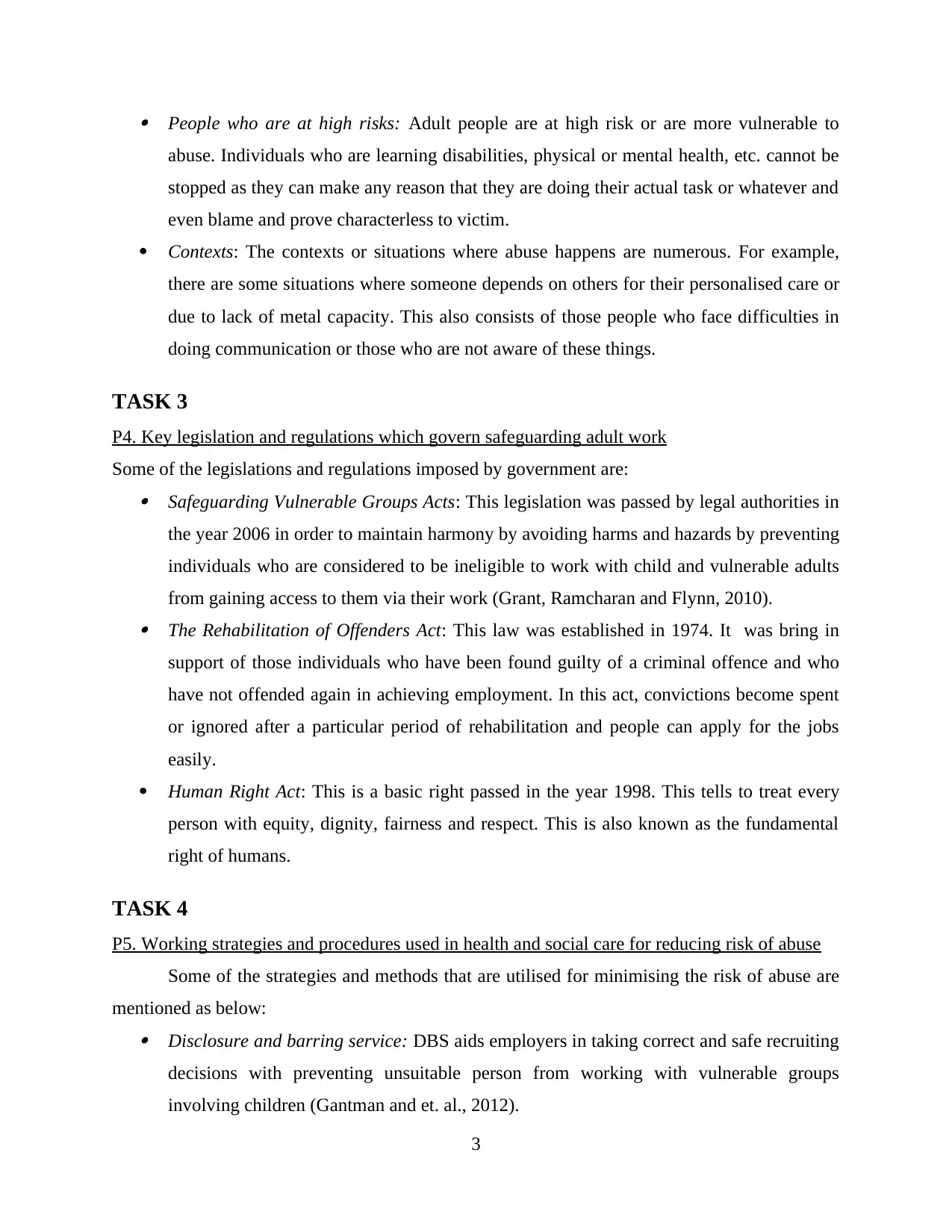
People who are at high risks: Adult people are at high risk or are more vulnerable to
abuse. Individuals who are learning disabilities, physical or mental health, etc. cannot be
stopped as they can make any reason that they are doing their actual task or whatever and
even blame and prove characterless to victim.
Contexts: The contexts or situations where abuse happens are numerous. For example,
there are some situations where someone depends on others for their personalised care or
due to lack of metal capacity. This also consists of those people who face difficulties in
doing communication or those who are not aware of these things.
TASK 3
P4. Key legislation and regulations which govern safeguarding adult work
Some of the legislations and regulations imposed by government are: Safeguarding Vulnerable Groups Acts: This legislation was passed by legal authorities in
the year 2006 in order to maintain harmony by avoiding harms and hazards by preventing
individuals who are considered to be ineligible to work with child and vulnerable adults
from gaining access to them via their work (Grant, Ramcharan and Flynn, 2010). The Rehabilitation of Offenders Act: This law was established in 1974. It was bring in
support of those individuals who have been found guilty of a criminal offence and who
have not offended again in achieving employment. In this act, convictions become spent
or ignored after a particular period of rehabilitation and people can apply for the jobs
easily.
Human Right Act: This is a basic right passed in the year 1998. This tells to treat every
person with equity, dignity, fairness and respect. This is also known as the fundamental
right of humans.
TASK 4
P5. Working strategies and procedures used in health and social care for reducing risk of abuse
Some of the strategies and methods that are utilised for minimising the risk of abuse are
mentioned as below: Disclosure and barring service: DBS aids employers in taking correct and safe recruiting
decisions with preventing unsuitable person from working with vulnerable groups
involving children (Gantman and et. al., 2012).
3
abuse. Individuals who are learning disabilities, physical or mental health, etc. cannot be
stopped as they can make any reason that they are doing their actual task or whatever and
even blame and prove characterless to victim.
Contexts: The contexts or situations where abuse happens are numerous. For example,
there are some situations where someone depends on others for their personalised care or
due to lack of metal capacity. This also consists of those people who face difficulties in
doing communication or those who are not aware of these things.
TASK 3
P4. Key legislation and regulations which govern safeguarding adult work
Some of the legislations and regulations imposed by government are: Safeguarding Vulnerable Groups Acts: This legislation was passed by legal authorities in
the year 2006 in order to maintain harmony by avoiding harms and hazards by preventing
individuals who are considered to be ineligible to work with child and vulnerable adults
from gaining access to them via their work (Grant, Ramcharan and Flynn, 2010). The Rehabilitation of Offenders Act: This law was established in 1974. It was bring in
support of those individuals who have been found guilty of a criminal offence and who
have not offended again in achieving employment. In this act, convictions become spent
or ignored after a particular period of rehabilitation and people can apply for the jobs
easily.
Human Right Act: This is a basic right passed in the year 1998. This tells to treat every
person with equity, dignity, fairness and respect. This is also known as the fundamental
right of humans.
TASK 4
P5. Working strategies and procedures used in health and social care for reducing risk of abuse
Some of the strategies and methods that are utilised for minimising the risk of abuse are
mentioned as below: Disclosure and barring service: DBS aids employers in taking correct and safe recruiting
decisions with preventing unsuitable person from working with vulnerable groups
involving children (Gantman and et. al., 2012).
3
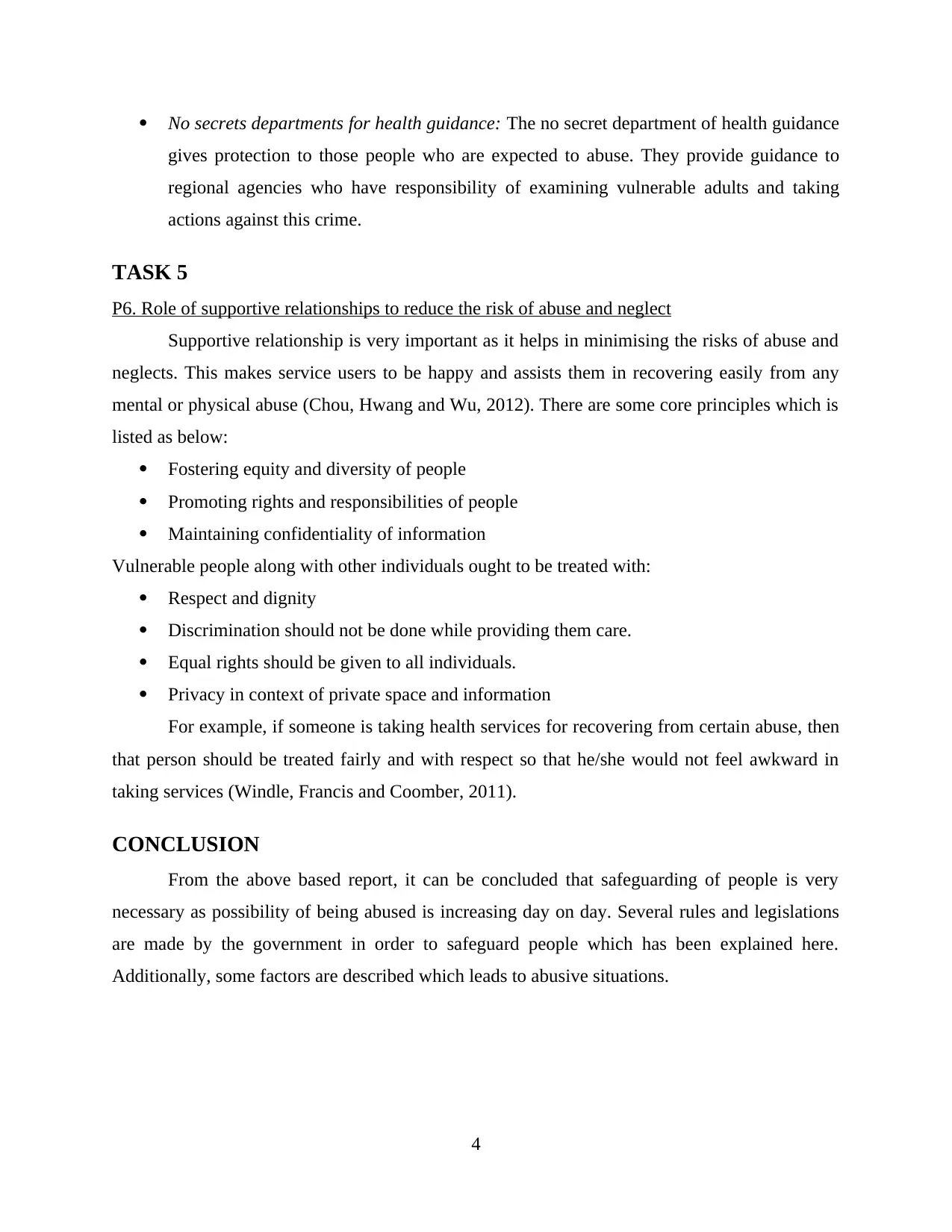
No secrets departments for health guidance: The no secret department of health guidance
gives protection to those people who are expected to abuse. They provide guidance to
regional agencies who have responsibility of examining vulnerable adults and taking
actions against this crime.
TASK 5
P6. Role of supportive relationships to reduce the risk of abuse and neglect
Supportive relationship is very important as it helps in minimising the risks of abuse and
neglects. This makes service users to be happy and assists them in recovering easily from any
mental or physical abuse (Chou, Hwang and Wu, 2012). There are some core principles which is
listed as below:
Fostering equity and diversity of people
Promoting rights and responsibilities of people
Maintaining confidentiality of information
Vulnerable people along with other individuals ought to be treated with:
Respect and dignity
Discrimination should not be done while providing them care.
Equal rights should be given to all individuals.
Privacy in context of private space and information
For example, if someone is taking health services for recovering from certain abuse, then
that person should be treated fairly and with respect so that he/she would not feel awkward in
taking services (Windle, Francis and Coomber, 2011).
CONCLUSION
From the above based report, it can be concluded that safeguarding of people is very
necessary as possibility of being abused is increasing day on day. Several rules and legislations
are made by the government in order to safeguard people which has been explained here.
Additionally, some factors are described which leads to abusive situations.
4
gives protection to those people who are expected to abuse. They provide guidance to
regional agencies who have responsibility of examining vulnerable adults and taking
actions against this crime.
TASK 5
P6. Role of supportive relationships to reduce the risk of abuse and neglect
Supportive relationship is very important as it helps in minimising the risks of abuse and
neglects. This makes service users to be happy and assists them in recovering easily from any
mental or physical abuse (Chou, Hwang and Wu, 2012). There are some core principles which is
listed as below:
Fostering equity and diversity of people
Promoting rights and responsibilities of people
Maintaining confidentiality of information
Vulnerable people along with other individuals ought to be treated with:
Respect and dignity
Discrimination should not be done while providing them care.
Equal rights should be given to all individuals.
Privacy in context of private space and information
For example, if someone is taking health services for recovering from certain abuse, then
that person should be treated fairly and with respect so that he/she would not feel awkward in
taking services (Windle, Francis and Coomber, 2011).
CONCLUSION
From the above based report, it can be concluded that safeguarding of people is very
necessary as possibility of being abused is increasing day on day. Several rules and legislations
are made by the government in order to safeguard people which has been explained here.
Additionally, some factors are described which leads to abusive situations.
4
⊘ This is a preview!⊘
Do you want full access?
Subscribe today to unlock all pages.

Trusted by 1+ million students worldwide
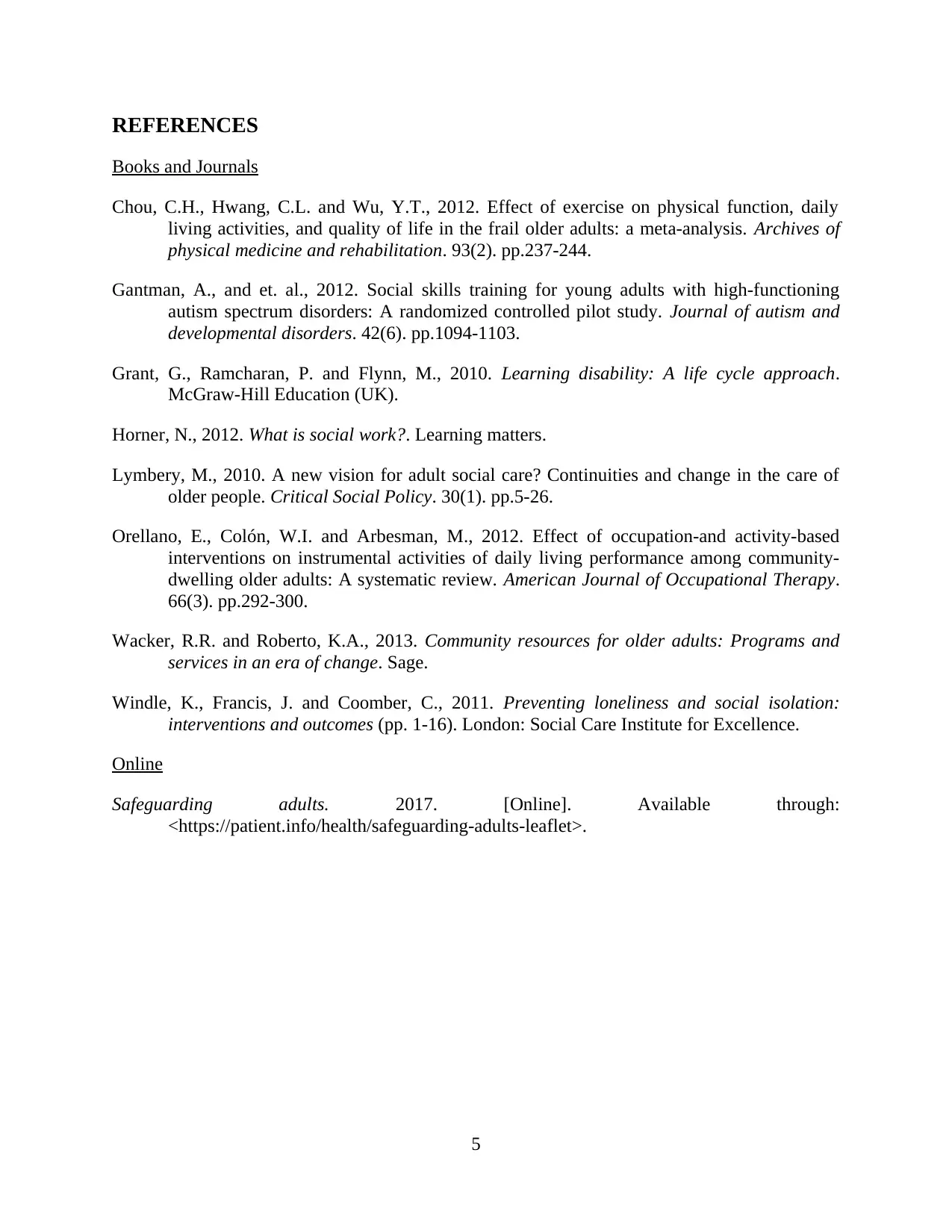
REFERENCES
Books and Journals
Chou, C.H., Hwang, C.L. and Wu, Y.T., 2012. Effect of exercise on physical function, daily
living activities, and quality of life in the frail older adults: a meta-analysis. Archives of
physical medicine and rehabilitation. 93(2). pp.237-244.
Gantman, A., and et. al., 2012. Social skills training for young adults with high-functioning
autism spectrum disorders: A randomized controlled pilot study. Journal of autism and
developmental disorders. 42(6). pp.1094-1103.
Grant, G., Ramcharan, P. and Flynn, M., 2010. Learning disability: A life cycle approach.
McGraw-Hill Education (UK).
Horner, N., 2012. What is social work?. Learning matters.
Lymbery, M., 2010. A new vision for adult social care? Continuities and change in the care of
older people. Critical Social Policy. 30(1). pp.5-26.
Orellano, E., Colón, W.I. and Arbesman, M., 2012. Effect of occupation-and activity-based
interventions on instrumental activities of daily living performance among community-
dwelling older adults: A systematic review. American Journal of Occupational Therapy.
66(3). pp.292-300.
Wacker, R.R. and Roberto, K.A., 2013. Community resources for older adults: Programs and
services in an era of change. Sage.
Windle, K., Francis, J. and Coomber, C., 2011. Preventing loneliness and social isolation:
interventions and outcomes (pp. 1-16). London: Social Care Institute for Excellence.
Online
Safeguarding adults. 2017. [Online]. Available through:
<https://patient.info/health/safeguarding-adults-leaflet>.
5
Books and Journals
Chou, C.H., Hwang, C.L. and Wu, Y.T., 2012. Effect of exercise on physical function, daily
living activities, and quality of life in the frail older adults: a meta-analysis. Archives of
physical medicine and rehabilitation. 93(2). pp.237-244.
Gantman, A., and et. al., 2012. Social skills training for young adults with high-functioning
autism spectrum disorders: A randomized controlled pilot study. Journal of autism and
developmental disorders. 42(6). pp.1094-1103.
Grant, G., Ramcharan, P. and Flynn, M., 2010. Learning disability: A life cycle approach.
McGraw-Hill Education (UK).
Horner, N., 2012. What is social work?. Learning matters.
Lymbery, M., 2010. A new vision for adult social care? Continuities and change in the care of
older people. Critical Social Policy. 30(1). pp.5-26.
Orellano, E., Colón, W.I. and Arbesman, M., 2012. Effect of occupation-and activity-based
interventions on instrumental activities of daily living performance among community-
dwelling older adults: A systematic review. American Journal of Occupational Therapy.
66(3). pp.292-300.
Wacker, R.R. and Roberto, K.A., 2013. Community resources for older adults: Programs and
services in an era of change. Sage.
Windle, K., Francis, J. and Coomber, C., 2011. Preventing loneliness and social isolation:
interventions and outcomes (pp. 1-16). London: Social Care Institute for Excellence.
Online
Safeguarding adults. 2017. [Online]. Available through:
<https://patient.info/health/safeguarding-adults-leaflet>.
5
1 out of 7
Related Documents
Your All-in-One AI-Powered Toolkit for Academic Success.
+13062052269
info@desklib.com
Available 24*7 on WhatsApp / Email
![[object Object]](/_next/static/media/star-bottom.7253800d.svg)
Unlock your academic potential
Copyright © 2020–2025 A2Z Services. All Rights Reserved. Developed and managed by ZUCOL.





